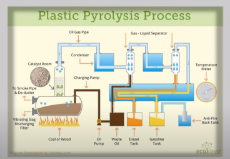Environmental issues get convoluted by politics all of the time, but I think something that we can all agree on is that the amount of plastic waste piling up all over the world sucks. Microplastics have permeated virtually every organic lifeform on this planet, and it's difficult to even begin to find their impacts on humans because it's impossible to find a control group. Plastic companies lied to the public for decades with the recycling meme, and as it stands most plastics are fundamentally unrecycleable. Despite all of the problems, global plastic production continues to skyrocket. There's garbage everywhere and there's no end in sight. What the fuck can be done about this?
/mlpol/ - My Little Politics
Archived thread
1667490116.jpg (131.9 KB, 1024x536, 138608_shutterstock_426187984_hero.jpg)

>>355253
[YouTube] How Plastic Waste Is Converted Into Fuel At A New Plant In Indiana![]()
there are some plants were i live and i saw lots of them in egypt and asia.
turn it into fuel, oil, diesel.
[YouTube] How Plastic Waste Is Converted Into Fuel At A New Plant In Indiana
there are some plants were i live and i saw lots of them in egypt and asia.
turn it into fuel, oil, diesel.
i did a research on this stuf flong ago for my engineering university and learned that many people in their farms collect plastics and do their own fuel for old tractors and farm machinery, they have very rudimentary equipment but the basics of the idea can be seen in videos like this one. so we better start collecting plastics because for when the fuel apocalipse begins hahah
https://www.youtube.com/watch?v=YGEzA-tbX8g
https://www.youtube.com/watch?v=YGEzA-tbX8g
>>355277
Can all plastic be turned into fuel though, or just certain kinds? It seems even less realistic than recycling to me, tbh.
Pic unrelated
Can all plastic be turned into fuel though, or just certain kinds? It seems even less realistic than recycling to me, tbh.
Pic unrelated
>>355279
look>
at high temperature and pressure from tires to bottles>
[YouTube] How Waste Plastic is Converted into Fuel | Plastic Pyrolysis | Karthi Explains![]()
look>
at high temperature and pressure from tires to bottles>
[YouTube] How Waste Plastic is Converted into Fuel | Plastic Pyrolysis | Karthi Explains
>>355279
Pyrolisis is a very well know form of recycling plastics into fuel and byproducts with minimum waste
check the lots of videos about it>
https://www.youtube.com/results?search_query=pyrolisis+percentages+tyres
Pyrolisis is a very well know form of recycling plastics into fuel and byproducts with minimum waste
check the lots of videos about it>
https://www.youtube.com/results?search_query=pyrolisis+percentages+tyres
>>355253
I'm banking on plastic-eating bacteria/enzymes, which have already been found in nature, and apparently even improved upon past that. Once they become ubiquitous, I think the microplastics will be a solved problem too. Not sure when we'll get something we can ingest to clean out the microplastics, but here's for hoping.
I'm banking on plastic-eating bacteria/enzymes, which have already been found in nature, and apparently even improved upon past that. Once they become ubiquitous, I think the microplastics will be a solved problem too. Not sure when we'll get something we can ingest to clean out the microplastics, but here's for hoping.
>>355283
I wouldn't bank on that, tbh. Nature doesn't work quickly, and plastic polymers are all so different from eachother that no one organism could break down even a tenth of them.
I wouldn't bank on that, tbh. Nature doesn't work quickly, and plastic polymers are all so different from eachother that no one organism could break down even a tenth of them.
>>355336
Yeah, you're probably right, but if that's the case, then I suppose the next hope in that direction is for AI to design the enzymes needed to break them down. In which case, we're probably still several years out from anything there.
Yeah, you're probably right, but if that's the case, then I suppose the next hope in that direction is for AI to design the enzymes needed to break them down. In which case, we're probably still several years out from anything there.
>>355338
That's why waiting for technological solutions is a non-solution. Plastic waste is already a huge problem, and it's production just keeps increasing.
For nearly a century it's been marketed as a "disposable" substance, but in reaity it's anything but.
That's why waiting for technological solutions is a non-solution. Plastic waste is already a huge problem, and it's production just keeps increasing.
For nearly a century it's been marketed as a "disposable" substance, but in reaity it's anything but.
>>355339
It's those fucking third worlders. When we send boats and drones to clean the oceans, they keep tossing their trash in the rivers and seas.
It's those fucking third worlders. When we send boats and drones to clean the oceans, they keep tossing their trash in the rivers and seas.
It is too late, plastic has already become portions of a new type of rock. We made a whole new layer in the geologic record in the span of 50 years.
https://en.wikipedia.org/wiki/Plastiglomerate
https://en.wikipedia.org/wiki/Plastiglomerate
>>355338
Ideonella sakaiensis has existed since 2016, the enzyme created that melts down the plastic for bacterial consumption is able to be mass produced, we just don't guess why.
Ideonella sakaiensis has existed since 2016, the enzyme created that melts down the plastic for bacterial consumption is able to be mass produced, we just don't guess why.
>>355352
TBTB fear synthetic biology. Synthetic biology has greater potential than AI and will make entire countries independent from global trade. Central bwankers cannot allow this.
TBTB fear synthetic biology. Synthetic biology has greater potential than AI and will make entire countries independent from global trade. Central bwankers cannot allow this.
1667611007_1.webm (3.9 MB, Resolution:960x540 Length:00:00:33, shooting star.webm) [play once] [loop]

1667611007_2.webm (2.9 MB, Resolution:720x1280 Length:00:00:28, maja kuczynska.webm) [play once] [loop]

1667611007_3.webm (3.9 MB, Resolution:1280x720 Length:00:00:15, dead_world_boogie.webm) [play once] [loop]

>>355281
>>355279
>>355280
Fischer-Tropsch process
https://www.youtube.com/watch?v=PBtgQU8Gvqk
Step 1: Get lots of money
Step 2: Build an offshore facility in the Pacific Vortex
Step 3: Use solar, wind, and abundant plastic waste to fuel your facility
Step 4: Get paid to take US plastic waste
Step 5: Invite gambling, prostitution, drugs, and most importantly: weapons research
Step 6: Rebuild the internet one server at a time
Step 7: Give yourself a cool name
Start assassinating jews and high profile anti-white faggots somewhere in between step 5 and 6.
Exports would be weapons tech, fabrics, pharma, and clean sea food that you'd be growing on your massive artificial reef.
>>355358
>>355352
You're thinking small. Biological solutions to plastic waste will be weaponized.
Plastic is what allows all modern electronics to exist. PVC, PP, and PE are all used in milspec applications.
A fungus, bacterium, or animal which digests plastic would cripple any facility.
There was a nuclear plant in the US that almost went into meltdown because PU spray foam failed, which caused a short in a wiring loom.
>>355279
>>355280
Fischer-Tropsch process
https://www.youtube.com/watch?v=PBtgQU8Gvqk
Step 1: Get lots of money
Step 2: Build an offshore facility in the Pacific Vortex
Step 3: Use solar, wind, and abundant plastic waste to fuel your facility
Step 4: Get paid to take US plastic waste
Step 5: Invite gambling, prostitution, drugs, and most importantly: weapons research
Step 6: Rebuild the internet one server at a time
Step 7: Give yourself a cool name
Start assassinating jews and high profile anti-white faggots somewhere in between step 5 and 6.
Exports would be weapons tech, fabrics, pharma, and clean sea food that you'd be growing on your massive artificial reef.
>>355358
>>355352
You're thinking small. Biological solutions to plastic waste will be weaponized.
Plastic is what allows all modern electronics to exist. PVC, PP, and PE are all used in milspec applications.
A fungus, bacterium, or animal which digests plastic would cripple any facility.
There was a nuclear plant in the US that almost went into meltdown because PU spray foam failed, which caused a short in a wiring loom.
>>355360
>There was a nuclear plant in the US that almost went into meltdown because PU spray foam failed, which caused a short in a wiring loom.
I misremembered that.
https://en.wikipedia.org/wiki/Browns_Ferry_Nuclear_Plant#Unit_1_fire
>On March 22, 1975 a fire started when a worker using a candle to search for air leaks accidentally set a temporary cable seal on fire. At Browns Ferry, foamed plastic, covered on both sides with two coats of a flame retardant paint, was used as a firestop. The fire spread from the temporary seal into the foamed plastic, causing significant damage to the reactor control cabling in the station.
>There was a nuclear plant in the US that almost went into meltdown because PU spray foam failed, which caused a short in a wiring loom.
I misremembered that.
https://en.wikipedia.org/wiki/Browns_Ferry_Nuclear_Plant#Unit_1_fire
>On March 22, 1975 a fire started when a worker using a candle to search for air leaks accidentally set a temporary cable seal on fire. At Browns Ferry, foamed plastic, covered on both sides with two coats of a flame retardant paint, was used as a firestop. The fire spread from the temporary seal into the foamed plastic, causing significant damage to the reactor control cabling in the station.
>>355281
Ah so this manages to make fuel without releasing so much noxious gases into the air, unlike directly burning the plastic?
Still, we need to do a better job of not consooming crappy foods wrapped in plastic. plastic is produced faster than a few pyrolisis plants can process the plastic. It would be better if people in the home made their own meals and tended to a vegetable garden instead of "watching Netflix" and being narcissistic on "social media"
Ah so this manages to make fuel without releasing so much noxious gases into the air, unlike directly burning the plastic?
Still, we need to do a better job of not consooming crappy foods wrapped in plastic. plastic is produced faster than a few pyrolisis plants can process the plastic. It would be better if people in the home made their own meals and tended to a vegetable garden instead of "watching Netflix" and being narcissistic on "social media"
>>355360
The FT process requires very high temperatures and pressures it's not a viable off grid solution. The biological approach is much more realistic and low energy solution. Imagine turning plastic into animal feed or hell just use it to make stronger mycelium composites. Bioweapons are stupid because there is no controlling that shit.
The FT process requires very high temperatures and pressures it's not a viable off grid solution. The biological approach is much more realistic and low energy solution. Imagine turning plastic into animal feed or hell just use it to make stronger mycelium composites. Bioweapons are stupid because there is no controlling that shit.
>>355667
>not a viable off grid solution
"Off grid" is just off the jew run grids. FT gives a sovereign people with an endless source of plastic an endless source of all major hydrocarbons.
You're thinking small if all you can see is a few solar panels and a few KW diesel generator.
>not a viable off grid solution
"Off grid" is just off the jew run grids. FT gives a sovereign people with an endless source of plastic an endless source of all major hydrocarbons.
You're thinking small if all you can see is a few solar panels and a few KW diesel generator.
>>355670
I see a few solar and diesel generators as the beginning so biotech would be better for starting something new. It will take a while before your microstate gets FT. Start small, baby steps my friend.
I see a few solar and diesel generators as the beginning so biotech would be better for starting something new. It will take a while before your microstate gets FT. Start small, baby steps my friend.
Can you post stats to show there's a "plastic problem"? Your picture is nice but doesn't prove anything.
>>355729
What kind of stats do you want? I could go digging if you really need convincing. My reason for making the thread was recently seeing that there's garbage all over the nearby beach all the time, and it wasn't like that 15 years ago. The problem gotten visibly worse.
What kind of stats do you want? I could go digging if you really need convincing. My reason for making the thread was recently seeing that there's garbage all over the nearby beach all the time, and it wasn't like that 15 years ago. The problem gotten visibly worse.
>>355729
Links aren't hard to find:
https://ourworldindata.org/plastic-pollution
https://www.oecd.org/environment/plastic-pollution-is-growing-relentlessly-as-waste-management-and-recycling-fall-short.htm
https://www.nationalgeographic.com/environment/article/plastic-pollution
https://www.pewtrusts.org/en/research-and-analysis/articles/2020/07/23/science-study-shows-that-nearly-80-percent-of-the-annual-plastic-flow-into-the-environment
Links aren't hard to find:
https://ourworldindata.org/plastic-pollution
https://www.oecd.org/environment/plastic-pollution-is-growing-relentlessly-as-waste-management-and-recycling-fall-short.htm
https://www.nationalgeographic.com/environment/article/plastic-pollution
https://www.pewtrusts.org/en/research-and-analysis/articles/2020/07/23/science-study-shows-that-nearly-80-percent-of-the-annual-plastic-flow-into-the-environment
>>355729
PET is the most used plastic in the world for both textiles and packaging.
You know it as Polyester.
If you see a hard, or crinkly, clear plastic in the store (chip bags, mylar, clear water bottles, clear ketchup bottles, etc)
PET is a known endocrine distributor because of the phthalate chains it contains.
The normal end of life state for PET plastic is micro plastics.
Micro plastics accumulate through food chains just like heavy metals.
In humans, micro plastics accumulate in filtering organs. In the case of PET, those micro plastics disrupt normal hormones, and because of the increased surface area and their accumulation in high blood flow areas, they will be far more effective at disrupting hormones.
In the case of inert plastics like PP and PE, those plastics will cause sclerosis.
Look at the faces of 3D printing to see what I mean.
Those involved at a hobby level that print high quantities of PET have similar physiques and opinions.
3D printing stringing material produces insane quantities of microplastics. PET is often touted as a "non-toxic" alternative to ABS, and most hobbyists don't print in a filtered box.
>They're turning the freaking frogs gay
PET micro plastics will accumulate on the mother's side of the placenta, and possibly pass through.
But the phthalates leeched from the PET definitely cross the placenta.
PET is the most used plastic in the world for both textiles and packaging.
You know it as Polyester.
If you see a hard, or crinkly, clear plastic in the store (chip bags, mylar, clear water bottles, clear ketchup bottles, etc)
PET is a known endocrine distributor because of the phthalate chains it contains.
The normal end of life state for PET plastic is micro plastics.
Micro plastics accumulate through food chains just like heavy metals.
In humans, micro plastics accumulate in filtering organs. In the case of PET, those micro plastics disrupt normal hormones, and because of the increased surface area and their accumulation in high blood flow areas, they will be far more effective at disrupting hormones.
In the case of inert plastics like PP and PE, those plastics will cause sclerosis.
Look at the faces of 3D printing to see what I mean.
Those involved at a hobby level that print high quantities of PET have similar physiques and opinions.
3D printing stringing material produces insane quantities of microplastics. PET is often touted as a "non-toxic" alternative to ABS, and most hobbyists don't print in a filtered box.
>They're turning the freaking frogs gay
PET micro plastics will accumulate on the mother's side of the placenta, and possibly pass through.
But the phthalates leeched from the PET definitely cross the placenta.
From the map you posted, it looks as though it's a 3rd world problem.
>>355736
It absolutely is not just a third world problem. A go-to solution has been to ship it to third world countries for a price, where it eventually gets dumped in the ocean.
(You) have plastic in your blood right now. It's in everyone, and it's fucking up people's hormones. I wouldn't be surprised if it's contributing to the explosion of troons and faggots this century.
It absolutely is not just a third world problem. A go-to solution has been to ship it to third world countries for a price, where it eventually gets dumped in the ocean.
(You) have plastic in your blood right now. It's in everyone, and it's fucking up people's hormones. I wouldn't be surprised if it's contributing to the explosion of troons and faggots this century.
Water purifier master race
plastic in the water can't get in me
you should see and smell how fucking disgusting the inside of my water purifier looks after it's purified a few liters.
You'd swear a mud monster sharted explosive diarrhea into a campfire. It smells of burned dirt and chlorine and suffering. But that's just the shit in the water supply burned out of my drinking water.
plastic in the water can't get in me
you should see and smell how fucking disgusting the inside of my water purifier looks after it's purified a few liters.
You'd swear a mud monster sharted explosive diarrhea into a campfire. It smells of burned dirt and chlorine and suffering. But that's just the shit in the water supply burned out of my drinking water.
32 replies | 9 files | 19 UUIDs | Archived





 Ex: Type :littlepip: to add Littlepip
Ex: Type :littlepip: to add Littlepip  Ex: Type :eqg-rarity: to add EqG Rarity
Ex: Type :eqg-rarity: to add EqG Rarity 